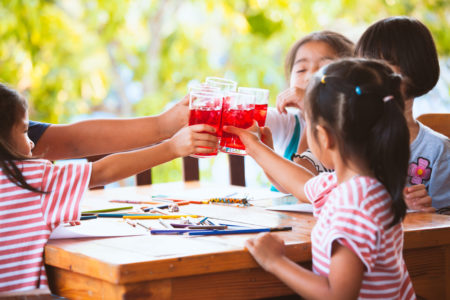Share On Social!
Sugary drinks can have a detrimental impact on people of all ages, which is why civic and health leaders across the US are working to curb consumption.
How are they doing this?
One of the main ways is through increasing taxes on soda, fruit juice, and other sugary drinks. These measures boost the price of sugary drinks to reduce consumption and create revenue for community health programs.
Two states—Washington and Rhode Island—have just proposed sugary drink taxes in hopes of improving public health, according to Dr. Amy Nunn, the executive director of the Rhode Island Public Health Institute (RIPHI).
“This important legislation will help alleviate hunger and promote healthy eating across Rhode Island,” Nunn told Rhode Island FOX affiliate WPRI12. “We are committed to developing innovative and long-term solutions to Rhode Island’s most pressing public health problems.”
Proposed Sugary Drink Legislation in Washington and Rhode Island
While both states have only put forth bills that aim to raise taxes on sugary drinks, the fact that movement is being made in this issue is promising.
In Washington (13% Latino), legislators modeled their bill off of recently introduced piece of legislation in Seattle. The proposal, Senate Bill 5371, would impose a 1.75 cent charge on every ounce of most sugary drinks.
How would that impact the consumer? For instance, a typical can of soda would cost an extra 21 cents.
Steps like these are important to make headway in public health, according to the bill’s sponsor, State Sen. June Robinson.
“It’s really clear that sugary drinks are the leading source of sugars in the American diet and are a significant factor in the increase of heart disease, high blood pressure, Type 2 diabetes and tooth decay,” Robinson told Washington State Wire. “The health impacts of sugary drinks are broadly felt and are especially acute among communities of color and low-income families.” 
On the other end of the US, state legislators in Rhode Island (18.5% Latino) are hoping to pass their own sugary tax bill — an important step in a state that has seen childhood obesity rates raise from 11.1% to 30% over the past 30 years.
This legislation would raise a 1.5 cent tax on every ounce of a sugary drink.
“I’m proud that this legislation will work to address major public health issues in Rhode Island by reducing the amount of sugary drinks consumed, all while providing healthier incentives for our most vulnerable population,” State Senator Valarie Lawson told Rhode Island FOX affiliate WPRI12.
Why are these measures so important? It all goes back to overall wellness, the experts say.
Historic Sugary Drink Issues and Tax Laws
Across the board, sugary drinks harm America’s youth, according to Sugary Drink FACTS 2020, a recent report from the Rudd Center for Food Policy & Obesity.
“Sugary drink consumption by children and teens remains a significant public health concern,” researchers state in the Rudd report. “More than one-half of youth consume at least one sugary drink on a given day. Sugary drinks contribute approximately one-half of added sugars in young people’s diets, with teens and young adults consuming more sugary drinks than other age groups.”
When it comes to disparities in sugary drink consumption and impacts, people of color are among those facing targeted messaging despite rampant health concerns in those communities.
This contributes to the overconsumption of sugary drinks.
“Consumption is also higher among low-income youth and non-Hispanic Black and Mexican-American children and teens,” researchers state in the Rudd report. “Disproportionate sugary drink consumption raises additional concerns about health disparities affecting low-income youth and communities of color.”
Still, taxes like the ones proposed in Washington and Rhode Island can make an impact, according to Healthy Food America — who report that sugary drinks taxes have reduced the number of sugary drinks bought by consumers.
Studies have found that a 10% increase in sugary drink prices can reduce consumption by up to 12.1%, according to our Salud America! research review. 
Another recent report from Mathmatica illustrates further benefits.
Researchers examined the impact of taxes in four cities: Philadelphia, San Francisco, Seattle, and Oakland. They compared changes in household monthly purchases to nearby cities and a matched set of households nationally.
Sugary drink taxes that impacted the pricing of drinks led to a 12.2% decrease in consumption.
They also have shown to improve overall wellness in those communities by creating new revenue sources for health programs. Seattle even used revenue from its soda tax to give emergency grocery vouchers to low-income families when COVID-19 struck.
Dr. Ritchie Kapoor, a practicing heart specialist and president-elect of the Board of Directors of the American Heart Association Puget Sound, supports these measures.
“I support a statewide tax on sugary drinks as both a tool for improving health outcomes and raising critical funds to invest in communities that have long experienced health inequalities. There is very clear science linking sugary drinks to negative health outcomes.”
What You Can Do
The main point of sugary drink taxes are to promote a healthy life style for all Americans.
This should be especially important amid a global pandemic, according to Rhode Island State Rep. Jean Philippe Barros.
“The pandemic has brought many things to light, particularly around food access and health disparities in our most vulnerable populations, and we need to make the appropriate investments to help correct this,” Barros told Rhode Island FOX affiliate WPRI12.
Studies show that cutting sugary drink consumption can make a big impact, especially on children — even reducing the risk of cancer.
For those wanting to take immediate action in their children’s lives can do so.
Salud America! also created an Action Pack to help school leaders push for Water Bottle Fountains in schools. These refilling fountains can increase students’ access to safe, filtered water throughout the school day, as opposed to classic fountains.
GET A WATER BOTTLE FOUNTAIN FOR YOUR SCHOOL!
Explore More:
Healthy FoodBy The Numbers
142
Percent
Expected rise in Latino cancer cases in coming years



